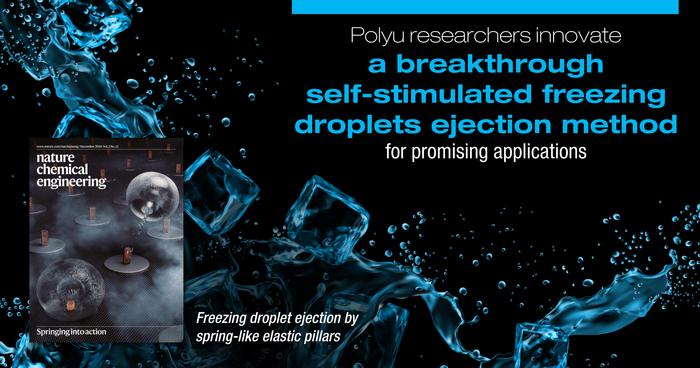
Revolutionary Method Unveiled for Self-Stimulated Ejection of Freezing Droplets: A Mechanism Inspired by Nature
In a remarkable breakthrough in the field of mechanical engineering, researchers from The Hong Kong Polytechnic University (PolyU) have developed an innovative technique that allows freezing droplets to self-eject from surfaces without the need for external energy sources. This transformative mechanism takes inspiration from the natural world, particularly the capabilities of certain fungi that can propel their spores away from their parent organism. By mimicking this biological process, scientists have paved the way for groundbreaking applications in various industries, especially in de-icing technologies.
One of the primary challenges in environments with freezing temperatures is that water droplets tend to stick to surfaces due to stronger droplet-surface interactions. At elevated temperatures, droplets can easily roll off surfaces, but under freezing conditions, they are hindered by the freezing process and strong adhesion. This often requires manual removal or mechanical intervention, which are both time-consuming and costly. Therefore, the ability to prevent droplet accumulation and automatically eject freezing droplets presents both a scientific challenge and a practical need.
The research team, led by Professor Zuankai Wang and Professor Haimin Yao from PolyU’s Department of Mechanical Engineering, has introduced a self-powered mechanism capable of ejecting freezing droplets effectively. This research has garnered significant attention, being featured as the cover article in the prestigious journal Nature Chemical Engineering, highlighting its importance and novelty within the scientific community.
The intricate mechanism behind this self-ejection phenomenon draws parallels to the way certain fungi eject their spores. These fungi utilize osmosis-induced volume expansion to propel their spores, an idea that caught the researchers’ attention. By replicating this natural mechanism, they developed a structured elastic surface (SES) comprised of spring-like pillars designed to facilitate the ejection of freezing droplets. This innovative structure not only allows for spontaneous droplet ejection but does so without requiring any external energy input.
The SES is engineered to maximize the velocity at which droplets are ejected and to enhance the kinetic energy transformation that occurs during this process. As the freezing droplet expands, it compresses the elastic pillars of the SES. The energy from the volume expansion is initially stored as elastic energy in the pillars within a matter of seconds. This energy is then rapidly transformed into kinetic energy, enabling the droplet to overcome droplet-surface adhesion and launch itself away in just milliseconds.
This remarkable reduction in the timescale of energy conversion is a critical factor, allowing droplets to achieve sufficient kinetic energy for ejection. The SES structure proves exceptionally effective in ejecting freezing droplets, capable of overcoming wind and gravitational forces, thus offering a versatile solution for a variety of settings, including aircraft wings, wind turbine blades, and cable lines.
Dr. Huanhuan Zhang, a key contributor to this research, expressed enthusiasm about the implications of this self-powered mechanism. He emphasized that this is the first time a concept for self-powered ice removal has been introduced, which could lead to a wide range of innovative solutions in various fields. The ongoing development of the SES design aims to ensure it can be produced at scale and remain cost-effective, meeting both present and future demands.
Moreover, researchers have created a theoretical model that elucidates the factors guiding the successful onset of the freezing droplet ejection phenomenon. This scalable design holds the promise of practical applications not just in the domain of anti-icing, but also in energy harvesting and soft robotics. By harnessing principles observed in nature, this project serves as a reminder of the potential synergy between scientific discovery and ecological insights.
In addition to advancing de-icing technology, the implications of this research extend into the realm of energy conversion. The self-ejection of droplets induced by volume expansion enhances our understanding of multi-phase freezing dynamics and could inspire the development of new energy-generating devices. As Professor Yao remarked, their work provides a strategy to effectively mitigate ice accumulation while exploring energy conversion phenomena that can lead to novel applications.
Ultimately, this research opens the door for a variety of impactful applications across several domains. From anti-icing systems for transportation infrastructure to self-powered energy devices in harsh environments, the potential for this self-ejecting mechanism is vast. The research community eagerly anticipates future developments that could emerge from this integration of biological inspiration and advanced engineering.
Through this groundbreaking work, PolyU researchers are not only addressing a critical practical problem but are also demonstrating an innovative approach that could influence a wide array of fields. Their journey has just begun, and the ongoing refinement of the SES design promises even further advancements in the understanding and application of energy harvesting and mechanical engineering principles inspired by nature.
As they look towards the future, the interdisciplinary implications of this research underscore the close relationship between biological systems and engineered solutions. With continued exploration and development, this technology could become an integral part of modern engineering solutions, creating pathways to improved efficiency and sustainability in numerous applications.
Subject of Research: Self-stimulated ejection of freezing droplets
Article Title: Freezing droplet ejection by spring-like elastic pillars
News Publication Date: 6-Dec-2024
Web References: https://www.nature.com/articles/s44286-024-00150-1
References: http://dx.doi.org/10.1038/s44286-024-00150-1
Image Credits: © 2025 Research and Innovation Office, The Hong Kong Polytechnic University. All Rights Reserved.
Keywords





